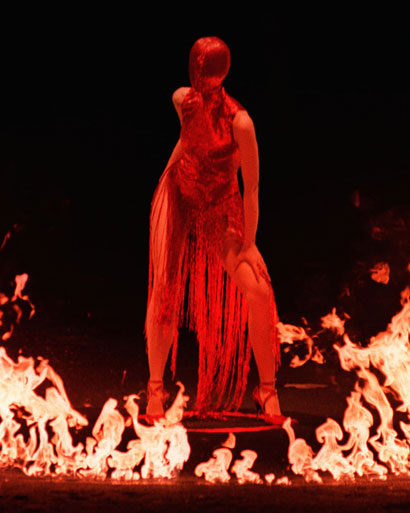It is often assumed that fashion and beauty are synonymous
with one another. Beauty is aspirational, seemingly achievable, and certainly
profitable. High-profile designers curate advertisements selling not only a
product, but a lifestyle, and men and women alike buy into the fantasy on a
daily basis. Fashion rarely explores the grotesque, the ‘ugly’, because it is not
profitable and, ultimately, a fashion house cannot survive without profit.
We see designers – new, young designers like J.W Anderson
and Christopher Kane, both of which have built their reputation on repurposing the
banal. One collection saw Kane using repurposed materials, creating
mini-dresses from refuse sacks, whereas Anderson sought to give a high-fashion
makeover to the most banal clothing category imaginable; the uniform. This was,
in some ways, a radical move as uniform clothing is the antithesis of the
fashion industry and its purpose. Fashion is supposed to provide us with
choice, whereas a uniform is built for routine. We are supposed to discover our
own style based on our preferences, whereas a uniform is rudely thrust upon us –
when we are uniformed, we represent an institution as opposed to an individual.
Both designers were successful because they challenged
standards of beauty – Kane rebuked the notion that luxury fabrics are
imperative to high fashion, whereas Anderson rebelled against the implication
of uniformity as mundanity whilst also destroying gender codes (men in heels,
anybody?) However, they were also successful because they pushed the envelope
just far enough to be marginally radical yet to not alienate potential clients.
Kane’s vinyl skirts even landed him huge sponsorship, whereas Anderson’s
collection was, despite the male models and their vertiginous platforms,
commercially-viable. Both designers ventured outside the expected affiliation
of fashion and beauty, but they did not fully explore the grotesque.
The most obvious example of a designer that did fully
explore the grotesque was the late Alexander McQueen, a man consistently
fascinated by the macabre. Inspired heavily by the Gothic and Victorian
periods, McQueen turned heads from the moment he chose to base his graduate
collection on infamous serial killer Jack the Ripper. From this point onwards
he sought to shock his audience by using blood, grease and even live locusts in
a series of early runway presentations which established his reputation as
fashion’s enfant terrible.
The McQueen woman was, in essence, not particularly
feminine. She was rebellious, storming down runways and flicking the middle
finger at anybody that caught her eye. In Highland
Rape she was covered in dirt, her clothing ripped and her behaviour feral,
whereas in Dante she was a kind of
satanic seductress. References to decay and violence were rife throughout the
designer’s work, with one woman playing the part of Joan of Arc in the
notorious A/W 1998 collection, Joan –
the show climaxed with the young model being seemingly incinerated on the
runway.
These references to decay, death, the disgusting, the ugly; they
are not beautiful, nor are they commercial. The plastic corset with the live
locusts underneath was, as you can probably imagine, a showpiece. As were the
metal shackles he commissioned for La
Poupée, which were attached to model Debra Shaw as she struggled to walk
the water-soaked runway.
It is important to
note that the risks taken by the designer increased significantly after he
secured a position as Creative Director of Givenchy in 1996, famously using his
astronomical paycheques to fund his own label and allow his mind to wander
free, deep into the depths of depravity. These might have been showpieces, but
they certainly rebuked the preconception that something has to be beautiful to
be “fashion”. The designer found his inspiration in the depths of ugliness
ignored by society and, in doing so, he earned a reputation as one of the most
innovative talents in modern fashion. Not all designers have to be McQueen –
they don’t have to smear models with mud or cover them in live insects to
capture attention on the runway. On the other hand, they certainly don’t have
to prescribe to social ideals of beauty either.


No comments:
Post a Comment